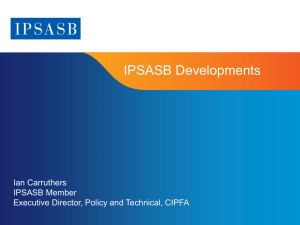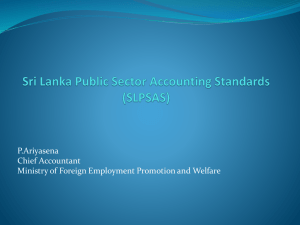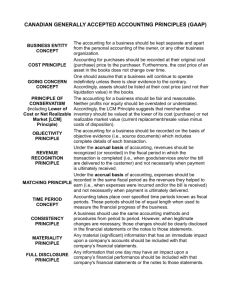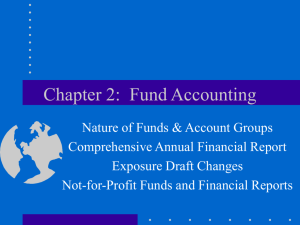Strategic Report * [Insert Board/Committee - PFM blog
advertisement
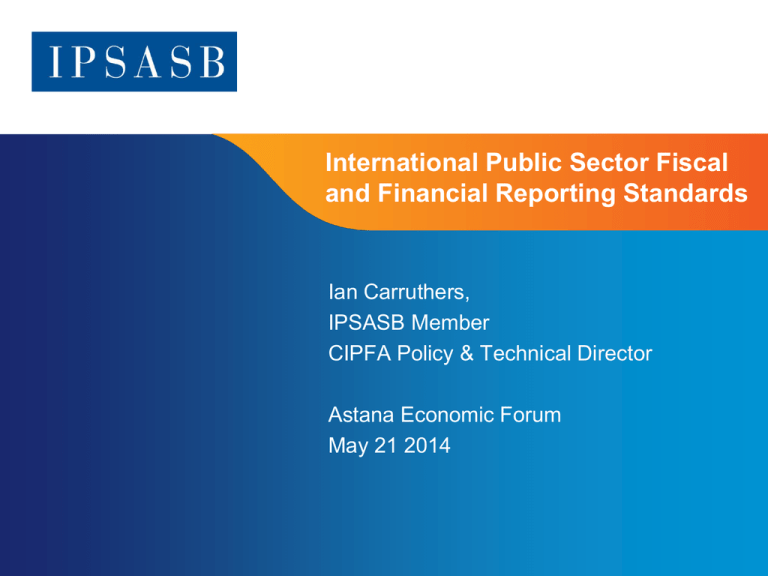
International Public Sector Fiscal and Financial Reporting Standards Ian Carruthers, IPSASB Member CIPFA Policy & Technical Director Astana Economic Forum May 21 2014 Session overview • Need for increased transparency and comparability • IPSASB – Background – Current work – Future plans • IPSAS and Government Finance Statistics • Strengthening PFM and fiscal policy in practice – UK transition – Embedding accrual – Changing the culture Importance of accrual to strong PFM: Recognition from G20 Leaders ‘In pursuit of our goal of strengthening the public sector balance sheet, work is needed to better assess risks to public debt sustainability. This includes, inter alia, taking into account country-specific circumstances, looking at transparency and comparability of public sector reporting, and monitoring the impact of financial sector vulnerability on public debt.’ IMF Report on Fiscal Transparency, Accountability and Risk (1) • Analysis of the nature and scale of fiscal shocks during the crisis • Emergence of the components of a business case for PFM improvement • BUT substantial shortcomings in fiscal transparency: – Gaps and inconsistencies in fiscal transparency standards – Lags in governments’ implementation of international accounting and statistical reporting standards IMF Report on Fiscal Transparency, Accountability and Risk (2) IMF Report on Fiscal Transparency, Accountability and Risk (3) Strengthening fiscal transparency standards and practices through: • Reporting of assets and liabilities – impact of governments’ crisis-related interventions • Coverage – focus on General Government but Public Corporations important • Aligning budgets, accounts and statistics The IPSAS Board • IFAC Standard Setting Board • 18 volunteer board members from around world • Sets standards for Public Sector Entities except Government Business Enterprises (GBE) • Funding by IFAC (approx 50%) and voluntary contributions from Governments and observer organizations • 32 IPSAS (accrual basis) covering main areas of government activity, 1 cash basis standard • 2 Recommended Practice Guidelines (RPGs) 7 Overview of IPSASs “IPSASs are high quality global financial reporting standards for application by public sector entities other than Government Business Enterprises (GBEs)” • IPSASs set out – recognition, – measurement, – presentation and disclosure requirements dealing with transactions and events in general purpose financial statements • IPSASs on the accrual basis are mainly based on IFRSs but adapted to the public sector context where appropriate IPSASs: Convergance with IFRSs IFRS (Private Sector) • Terminology • Public sector examples • Public sector issues • Public sector guidance IPSASs (Public Sector) Page 9 | Confidential and Proprietary Information IPSASB: Developing high quality outputs Stakeholder Input Due Process Overview of the development of IPSASB‘s work program • Through financial support of international institutions Phase 1 development of first set of accounting standards (“Core Set”: IPSAS 1 – IPSAS 20) (1997-2002) Phase 2 • Issuance of first standards on public sector specific issues (IPSAS 21 – IPSAS 24) • Where relevant for the public sector, convergence (2003-2010) with IAS/IFRS as of 31.12.2008 achieved • Development of Conceptual Framework for the public sector • Focus on public sector specific issues as well as further (since 2010) development of existing standards (IFRSs convergence) Phase 3 Current work program of the IPSASB Public sector key characteristics / IPSASB work plan strategic themes Public Sector Conceptual Framework Phase 1: Role, Authority and Scope; Objectives and Users; Qualitative Characteristics; Reporting Entity Consultation Paper Exposure Draft Final CF Dec 2013 Phase 2: Elements and Recognition in Financial Statements Consultation Paper Exposure Draft Final CF Sep 2014 Phase 3: Measurement Consultation Paper Exposure Draft Final CF Sep 2014 Phase 4: Presentation Consultation Paper Exposure Draft Final CF Sep 2014 Public sector critical projects – progress • • • • • • • • • • Long-term Sustainability of Public Finances – Recommended Practice Guideline (RPG)1 issued 2013 Financial Statement Discussion and Analysis – RPG2 issued 2013 IPSAS and GFS ‘Rules of the Road’ First Time Adoption – ED 2013 Update of IPSASs 6-8 – includes Consolidated Financial Statements and Joint Arrangements, ED 2013 Reporting Service Performance – RPG ED 2013 Public Sector Specific Financial Instruments (active), update IPSAS 28-30 (on hold until completion of IFRS 9) Public Sector Combinations Emission Trading Schemes (joint with IASB) Social Benefits First-time adoption of accrual IPSASs • Principles to provide relief for first-time adopters previously on either cash or national standards • Brings together all exemptions for transitional period • Exemption groups: – Asset and liability recognition – Fair presentation – Others (e.g. deemed cost) • Comparative information optional during transitional period • Disclose date of adoption of accrual IPSAS and reconcile to accounts on previous basis • ED issued October 2013 • IPSAS by end 2014? IPSASB Social benefits project – story so far • Original CP 2004; EDs 2005 and 2007 • Further work on social benefits progressed indirectly in two areas: ― Phase 2 of the conceptual framework deals with elements, including the definition of a liability ― Reporting on the Long-term Sustainability of an Entity’s Finances (RPG1) guidance for reporting on long-term fiscal sustainability of governmental programs including social benefits • Social benefits most frequently rated as high priority project in IPSASB’s consultation on its 2013/2014 work program – Social benefits added to the IPSASB active work program at June 2013 meeting. Global adoption and implementation of IPSASs Completion of projects: • A number of implementation projects reached milestones or were fully completed in 2013 (e.g. Austria, Spain, Kazakhstan) • UN system has now completed all but two entities Good progress in others - aiming for completion within the next 2 to 3 years: • Strong development in Latin America (e.g. Chile, Colombia, Brazil, Panama, Costa Rica…) • …and South-East Asia (e.g. Indonesia, Malaysia, PR of China – rollout beyond pilot entities…) EPSAS development in the EU……. IPSASB consultation on Strategy from 2015 and Work Program 2015-2019 • First full consultation on strategy and work plan – Limited consultation on 2013-14 work plan – Further enhancement of IPSASB accountability following broadening of member base • Consultation period runs until July 31st 2014 Proposed Strategic Objective Strengthening public financial management (PFM) and knowledge globally through increasing adoption of accrual-based IPSASs by: a) developing high-quality financial reporting standards; b) developing other publications for the public sector; and c) raising awareness of the IPSASs and the benefits of their adoption. IPSASB Strategy: Inputs, Outputs and Outcomes Inputs Funding Staff IPSASB members IPSASB technical advisors Stakeholder input Operational procedures Outputs High-quality public sector financial reporting standards and other publications- IPSASs & RPGs Outcomes Improved ability of public sector entities to reflect the full economic reality of their finances as well as of stakeholders to understand Presentations, speeches and other outreach activities in order to engage with stakeholders Increased awareness of IPSASs and their public finance management benefits in order to influence their adoption IPSASB Work Program 2015-2019 • • • • Direction after completion of Conceptual Framework? Existing commitments identified Cash-Basis-IPSAS: quo vadis? Potential projects: – Address Public Sector specific issues – Maintain existing IPSASs – Converge with IFRSs – Other (differential reporting, <IR> etc) IPSASs – GFS project background • Objective: Enhance and promote the reconciliation and harmonization of IPSASs with GFS Reporting Guidelines. – Review progress since 2005 research report – Update for 2008 System of National Accounts (SNA) and development of new GFS Manual – Consider revisions to IPSAS 22 • Task Force, IPSASB and statistical community • Consultation paper October 2012 Benefits from using same data • Reductions in GFS report preparation time, costs, and effort • Improvements to: – Source data – Report quality, including timeliness – Report understandability and credibility Comparison of IPSAS and GFS (1) IPSAS and Government Finance Statistics both show: • Financial, accrual based information • Assets, liabilities, revenue and expenses • Comprehensive information on cash flows BUT: • Some fundamental differences • Some differences that can be addressed Comparison of IPSAS and GFS (2) Differences: • Objectives • Reporting entity • Recognition criteria - liabilities • Revaluations and other value changes: – Value vs volume – Realised/unrealised gains/losses UK Whole of Government Accounts: Reconciliation of public sector net debt 2011-12 2010-11 2009-10 £bn £bn £bn 1,347 1,186 1,228 (1008) (961) (1,135) (113) (108) (102) PFI contracts (30) (27) (25) Unamortised premium or discount on gilts (23) (15) (13) Tangible and intangible fixed assets 793 757 769 UK Asset Resolution (UKAR) net impact on net debt 83 94 59 Payables and receivables 40 46 9 Investments 17 17 11 - 16 27 1,106 1005 828 Net liabilities Net public service pensions liability Provisions Other Public sector net debt (National Accounts) UK Whole of Government Accounts: Reconciliation of current deficit 2011-12 2010-11 2009-10 £bn £bn £bn Net expenditure (WGA) 185 94 163 Public service pensions (52) 79 (51) Depreciation and Impairment of Assets (46) (60) (30) Capital grants (13) (18) (16) Provisions (5) (6) 27 Net gains/losses on sale of assets (1) (4) - 6 5 5 UK Asset Resolution (UKAR) net impact on net debt (1) (1) (1) Other 17 12 12 Current deficit (National Accounts) 90 101 109 Military equipment not capitalised Management of accrual / GFS differences • Choose accrual accounting policies in light of GFS needs – same treatment if consistent with requirements of both frameworks • Additional data - reduce to a minimum but some still needed • Chart of Accounts designed to allow dual classification • Allows single information system to be used Overview of CP issues 1. Extent of resolution of specific issues, and the basis for this assessment 2. Other areas where the IPSASB and/or the statistical community could address differences 3. Guidance on integrated Chart of Accounts 4. IPSASB’s future role with respect to reduction of differences 5. Options for IPSAS 22, Disclosure of Financial Information about the General Government Sector; and 6. Guidance in Study 14, Transition to the Accrual Basis of Accounting: Guidance for Governments and Government Entities (PV 1) Opportunities to reduce differencies: IPSASs 1. Reporting entity definition (IPSASs 6-8 revision) 2. Currency on issue / seigniorage (PS Financial Instruments project) 3. Subscriptions to international organizations (PS FI project) 4. Inventory measurement 5. Defense weapons – capitalization and classification 6. Measurement of assets, liabilities and net assets/equity 7. Transaction costs – costs of discposing of nonfinancial and financial assets 8. Financial statements – presentation, including classification and aggregates 9. Investments in unquoted shares (remeasurement gains/losses) Opportunities to reduce differences: GFS 1. Measurement of assets, liabilities and net assets/equity 2. Extractive industries – exploration and evaluation, development and production 3. Decommissioning / restoration costs 4. Public-private partnerships 5. Subscriptions to international organisations 6. Costs associated with R&D and intangible assets 7. Low-interest and interest-free loans IPSAS / GFS current state of play • Policy Paper: Process for Considering GFS Reporting Guidelines during Development of IPSASs (February 2014) • Work in progress: – Update of IPSASs 6-8 – Public sector financial instruments • Proposals for 2014 work plan consultation: – Measurement – public sector specific – Military equipment – Future of IPSAS 22 (Disclosure of General Government Sector information) • Web publication of table of differences – Autumn 2014 • Guidance on integrated Chart of Accounts - not for IPSASB to lead cipfa.org Strengthening PFM and fiscal policy in practice: The UK experience Ian Carruthers Policy and Technical Director, CIPFA cipfa.org Background: CIPFA ● Only professional accountancy body to specialise in public services ● Influences and shapes public finance landscape, promoting strong Public Financial Management (PFM) globally ● Supporting improved PFM ● The professional body for people in public finance cipfa.org CIPFA support for public sector Practical support for professionals and their organisations Educating and training professionals PFM & Governance - Advocacy & advice - Standards & guidance cipfa.org UK accrual journey (1): Gradual adoption across public sector ● Public corporations – commercial accounts ● Local government – partial then full accrual ● NHS providers – accrual from creation ● Central government – departments last to implement accrual cipfa.org UK accrual journey (2): Central Government (CG) ● Accrual accounts (1996-2001) ● Accrual budgets (2001-2004) ● Whole of Government Accounts (1999- 2011) ● Move to IFRS (2006-2011) ● Alignment project (2008-2012) cipfa.org UK accrual journey (3): WGA programme timetable Central Government Departments; NDPBs; and Devolved Administrations 01-02 02-03 04-05 07-08 03-04 05-06 Local Authorities; NHS Trusts; Public corporations 09-10 08-09 06-07 cipfa.org UK accrual journey (4): WGA data problems ● Development of 1500 body consolidation from scratch ● Data submission rates built gradually ● Poor timeliness ● Poor data quality ● Identification and agreement of intra- government balances and transactions – large discrepancies ● Integration with other Treasury systems – COINS cipfa.org UK accrual journey (5): Accrual accounting - lessons learned ● Clear mandate, political backing and statutory mandate ● Clear timetable and project plan with buy in ● Phased approach – demonstrates achievement and builds confidence ● Use of ‘dry runs’ to resolve issues ● Clear accountabilities and responsibilities between the centre, reporting entities with reviews by National Audit Office ● Sufficient capability and capacity to implement change ● Need to change culture as well as systems ● Starting with integrated programme would have saved time and money cipfa.org Embedding accrual (1): Accrual budgeting ● Scores economic impact of transactions against budget when they occur ● Recognises economic events regardless of when cash flow occurs ● Combines current cash inflows/outflows with future expected cash inflows/outflows ● More accurate picture of an entity's current financial position and future commitments cipfa.org Embedding accrual (2): Accrual budgeting – advantages ● Alignment of performance and accountability frameworks – what gets measured gets managed! • Transparent system with a single set of rules and numbers • Better decision-making – use of cost information • Improved risk management and stronger value for money incentives • Focus on asset management • Management of working capital cipfa.org Embedding accrual (3): Accrual budgeting - constraints • Data quality – needs to be sufficient for expenditure control • UK Phased implementation – address accounts problems, build confidence in data • Limited, though growing international experience • Need to align budget and accounting policies • Alignment with legislature approval process to avoid complexity……….. cipfa.org Embedding accrual (4): PFM framework alignment Then … Budgets Estimates 0 0 58 357 86 71 -3.8 Accruals Accounts Amounts included under each framework (£bn) for departments’ 2008-09 resource plans. Excludes devolved administrations. cipfa.org Embedding accrual (5): PFM framework alignment … and Now Budgets Estimates 0 0 0 470 0 0 22 Accruals Accounts Amounts included under each framework (£bn) for departments’ 2008-09 resource plans. Excludes devolved administrations. cipfa.org Embedding accrual (6): IPSAS vs GFS balance sheets cipfa.org Embedding accrual (7): Fiscal sustainability reports • Produced annually by independent Office for Budget Responsibility (OBR) • Based on WGA balance sheet • Potential fiscal impact of future government activity • 50-year projections of all public spending, revenues and significant financial transactions • Assumption of ‘unchanged policy’ • Apply demographic and economic assumptions to produce projections of the public finances over the next 50 years • Public finances likely to come under pressure over the longer term, primarily as a result of ageing population cipfa.org Embedding accrual (8): Long-term financial sustainability projections cipfa.org PFM – Changing the culture (1): The CIPFA FM Model ● Strong FM as corporate responsibility ● Is financial management where we want it to be? ● Identifies priority areas for improvement ● Allows tracking over time ● Can be used to benchmark between organisations ● Can test organisational leaders skills in financial management http://www.cipfa.org/services/advisory-and-transformation/financialmanagement-model cipfa.org PFM – Changing the culture (2): FM Model good practice statements Securing Stewardship Supporting Performance Enabling Transformation Leadership L1, L2 L3 - L5 L6, L7 People P1, P2 P3, P4 P5, P6 Processes PR 1 - PR10 PR11 - PR14 PR15, PR16 Stakeholders S1 – S3 S4 - S6 S7, S8 cipfa.org PFM – Changing the culture (3): CIPFA Role of CFO Statement www.cipfa.org/policy-and-guidance/reports/the-role-of-the-chief-financial-officer-in-publicservice-organisations cipfa.org PFM – Changing the culture (4): CIPFA Role of CFO Statement The CFO in a public service organisations: 1. is a key member of the Leadership Team, helping it to develop and implement strategy and to resource and deliver the organisation’s strategic objectives sustainably and in the public interest; 2. must be actively involved in, and able to bring influence to bear on, all material business decisions to ensure immediate and longer term implications, opportunities and risks are fully considered, and alignment with the organisation’s overall financial strategy; and 3. must lead the promotion and delivery by the whole organisation of good financial management so that public money is safeguarded at all times and used appropriately, economically, efficiently and effectively. To deliver these responsibilities the Chief Financial Officer: 4. must lead and direct a finance function that is resourced to be fit for purpose; and 5. must be professionally qualified and suitably experienced. cipfa.org Strengthening PFM and fiscal policy: Conclusions from UK experience • Better fiscal management information using ‘bottom-up’ audited accrual data • Accrual budgeting and accounting strengthens transparency and Public Financial Management • Need coordinated programme with linked changes in legislature approval and accountability processes • Longer term projections to highlight future fiscal challenges • PFM needs to be owned by whole entity, lead by Board-level qualified CFOs cipfa.org Questions / Discussion Ian Carruthers Director, Policy and Technical CIPFA E: ian.carruthers@cipfa.org www.cipfa.org
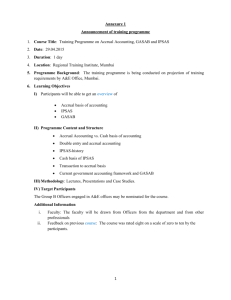
![Strategic Report * [Insert Board/Committee Acronym here]](http://s3.studylib.net/store/data/009757854_1-7855a7d89bd9fbeb299750104722b602-300x300.png)
